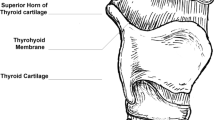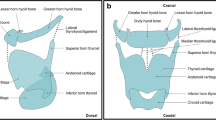Abstract
Purpose
This study aims to determine the presence and morphology of triticeal cartilage (TrC) through autopsy cases and to examine its relationship with age, gender, and height, thus contributing to clinical practices and forensic perspective.
Materials and methods
Our study was conducted on a total of 84 autopsy cases between the ages of 20–90 years who came to Tokat Forensic Medicine Institute. The laryngeal region was palpated to determine whether TrC was present. The dimensions of the TrC and the length of the upper horn of thyroid cartilage (UHThC) were measured with precise digital calipers, and its weight was measured with an accurate digital scale.
Results
The presence of TrC was identified in 56% of the autopsy cases examined. The prevalence of TrC was higher in males (61.9%) than in females (23.1%). It was determined to be bilateral in 45% of the cases and unilateral in 11%. TrCs had a cylindrical shape in 68.2%, an oval shape in 25.8%, and a pyramidal shape in 5.8%. The average weight of TrC was 67.93 ± 33.91 mg on the right side and 72.67 ± 32.23 mg on the left. As the individual’s height increased, the weight of TrC increased (p < 0.001). Additionally, there was a strong positive correlation between the lengths of TrC and UHThC and the individual’s height (p < 0.001).
Conclusion
TrC may be confused with UHThC fractures. Therefore, we believe that knowledge of the presence and morphology of TrC will contribute to clinical approaches and forensic cases, especially in relation to the neck region.


Similar content being viewed by others
References
Ahmad M, Madden R, Perez L (2005) Triticeous cartilage: prevalence on panoramic radiographs and diagnostic criteria. Oral Surg Oral Med Oral Pathol Oral Radiol Endod 99:225–230. https://doi.org/10.1016/j.tripleo.2004.06.069
Alqahtani E, Marrero DE, Champion WL, Alawaji A, Kousoubris PD, Small JE (2016) Triticeous cartilage CT imaging characteristics, prevalence, extent, and distribution of ossification. Otolaryngol Head Neck Surg 154:131–137. https://doi.org/10.1177/0194599815615350
Ajmani ML (1990) A metrical study of the laryngeal skeleton in adult Nigerians. J Anat 171:187–191
Carter LC (2000) Discrimination between calcified triticeous cartilage and calcified carotid atheroma on panoramic radiography. Oral Surg Oral Med Oral Pathol Oral Radiol Endod 90:108–110. https://doi.org/10.1067/moe.2000.106297
Di Nunno N, Lombardo S, Costantinides F, Di Nunno C (2004) Anomalies and alterations of the hyoid-larynx complex in forensic radiographic studies. Am J Forensic Med Pathol 25:14–19. https://doi.org/10.1097/01.paf.0000113931.49721.e4
Emre E, Akkoc RF, Ogeturk M (2022) Prevalence and distribution of triticeal cartilage. Folia Morphol 81:150–156. https://doi.org/10.5603/FM.a2020.0153
Grossman JW (1945) The triticeous cartilages. A roentgen-anatomic study. Am J Roentgenol 53:166–170
Joshi MM, Joshi SD, Joshi SS (2014) Prevalence and variations of cartilago triticea. Int J Anat Res 2:474–477. https://doi.org/10.16965/ijar
Koca R, Fazlıoğulları Z, Keleşoğlu KS, Koplay M, Karabulut AK (2020) Prevalence and clinical significance of the triticeal cartilage. Anatomy 14:97–101. https://doi.org/10.2399/ana.20.762981
Pinheiro J, Luis Cascallana J, Lopez de Abajo B, Luis Oteroc J, Rodriguez Calvo MS (2018) Laryngeal anatomical variants and their impact on the diagnosis of mechanical asphyxias by neck pressure. Forensic SciInt 290:1–10. https://doi.org/10.1016/j.forsciint.2018.06.019
Romano-Sousa CM, Krejci L, Medeiros FMM, Graciosafilho RG, Martins MFF, Guedes VN, Fenyo-Pereira M (2009) Diagnostic agreement between panoramic radiographs and color doppler images of carotid atheroma. J Appl Oral Sci 17:45–48. https://doi.org/10.1590/s1678-77572009000100009
Senanayake SMHMK (2015) Prevalence and features of triticea cartilage in an autopsy sample of tertiary care hospital in Sri Lanka. Medico-Legal J SL 2:1. https://doi.org/10.4038/mljsl.v2i1.7305
Tubbs RS, Dixon JF, Loukas M, Shoja MM, Cohen Gadol AA (2010) Relationship between the internal laryngeal nerve and the triticeal cartilage: a potentially unrecognized compression site during anterior cervical spine and carotid endarterectomy operations. Neurosurgery 66:ONS187–ONS190. https://doi.org/10.1227/01.NEU.0000369647.44961.87
Turk LM, Hogg DA (1993) Age changes in the human laryngeal cartilages. Clin Anat 6:154–162. https://doi.org/10.1002/ca.980060305
Vatansever A, Demiryürek D, Tatar İ, Özgen B (2018) The triticeous cartilage redefining of morphology, prevalence and function. Folia Morphol 77:758–763. https://doi.org/10.5603/FM.a2018.0034
Watanabe H, Kurihara K, Murai T (1982) A Morphometrical study of laryngeal cartilages. Med Sci Law 22:255–260. https://doi.org/10.1177/002580248202200406
Wilson I, Stevens J, Gnananandan J, Nabeebaccus A, Sandison A, Hunter A (2017) Triticeal cartilage: the forgotten cartilage. Surg Radiol Anat 39:1135–1141. https://doi.org/10.1007/s00276-017-1841-z
Funding
This research did not receive any specific grant from funding agencies in the public, commercial, or not-for-profit sectors.
Author information
Authors and Affiliations
Contributions
AD: Protocol/project development, Data collection or management, Manuscript writing/editing, SBS: Data analysis, Manuscript writing/editing, SS: Data analysis, Manuscript writing/editing, BD: Data analysis, Manuscript writing/editing, MNO: Data analysis, Manuscript writing/editing, BKO: Manuscript writing/editing, HIS: Data analysis, Manuscript writing/editing, All authors read and approved the final manuscript.
Corresponding author
Ethics declarations
Competing interests
The authors declare no competing interests.
Informed consent
A formal informed consent procedure was waived due to the retrospective nature of this study.
Data availability
The datasets used and/or analyzed in the current study are available from the corresponding author on reasonable request.
Ethical approval
All procedures performed in this study involving human participants were in accordance with the ethical standards of the institutional and/or national research committee and with the 1964 Helsinki declaration and its later amendments or comparable ethical standards. Approval for the study was obtained from the Forensic. Medicine Institute (21589509/2023/109) and Tokat Gaziosmanpaşa University Faculty of Medicine Clinical Research Ethics Committee (23-KAEK-020).
Additional information
Publisher's Note
Springer Nature remains neutral with regard to jurisdictional claims in published maps and institutional affiliations.
Rights and permissions
Springer Nature or its licensor (e.g. a society or other partner) holds exclusive rights to this article under a publishing agreement with the author(s) or other rightsholder(s); author self-archiving of the accepted manuscript version of this article is solely governed by the terms of such publishing agreement and applicable law.
About this article
Cite this article
Depreli, A., Simsek, S.B., Sonmez, S. et al. Investigation of triticeal cartilage anatomy in forensic autopsy cases. Surg Radiol Anat (2024). https://doi.org/10.1007/s00276-024-03375-0
Received:
Accepted:
Published:
DOI: https://doi.org/10.1007/s00276-024-03375-0




